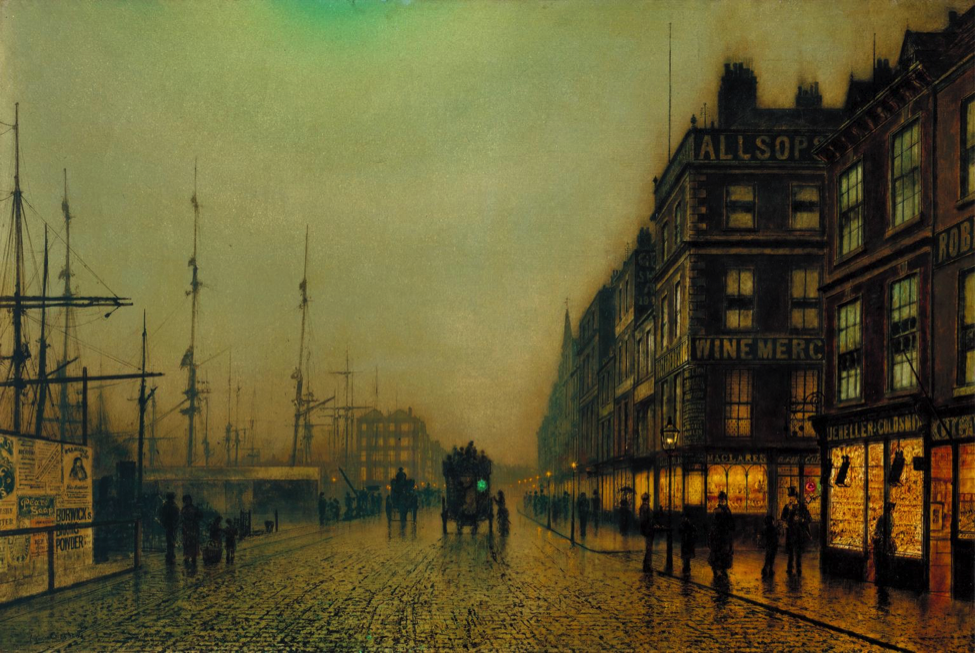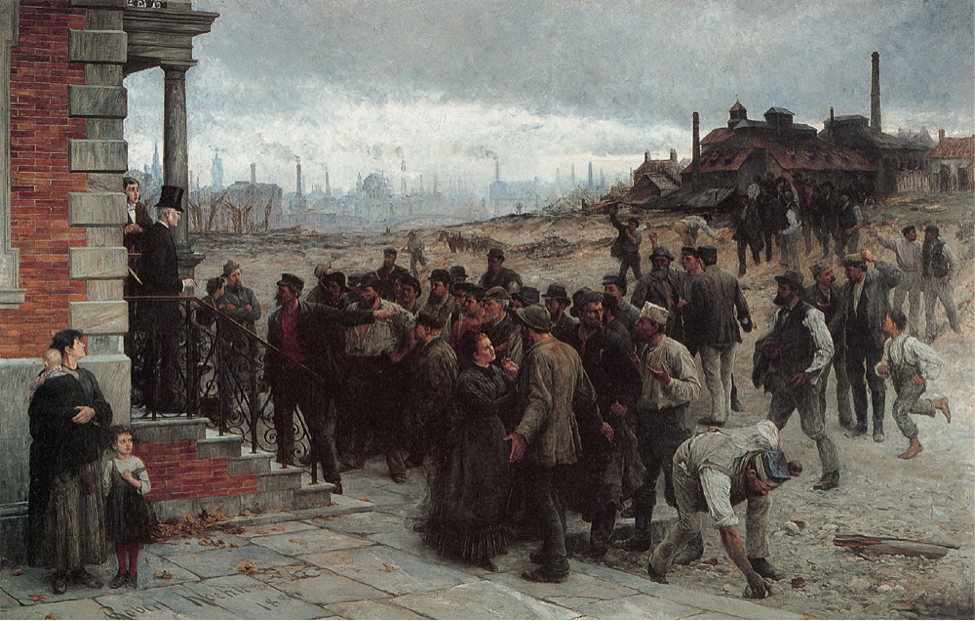This week’s guest, Thomas A. Laughlin, has a PhD in English from the University of Toronto.

William Wyld, Manchester from Kersal Moor, 1852
“Mrs. Gaskell could not just give what we would now call a ‘slice of life,’ partly because she wanted to offer more, but also partly because the novel as a form was felt to require movement, the progress of a story. This is the problem of form. Mrs. Gaskell has to overcome the difficulty that whereas her strength lies in evocation, description, analysis of a situation, the strength of the novel seemed to lie in the fact that it could absorb readers in a story, that is, that it worked through plot.” (Gill 22)
This is the famous contradiction and tension at the heart of Elizabeth Gaskell’s 1848 novel, Mary Barton. The novel gathers more content and conflicts than its narrative can adequately process. The plot, we have to admit, isn’t the greatest. Nor is there much satisfaction to be derived from the characters, who, in my opinion, are obstinately and unbelievably single-minded in their concerns and pursuits. But personally, I like that it begins in the countryside, dwells in the twisted streets and back alleys of a Manchester working-class neighborhood, traverses both the factory floor and the union meeting, brings back news of the Chartists’ disappointed presentation of the People’s Charter to the Parliament in London, connects the working class to the wandering “lumpen” masses, involves a secret assassination plot, follows Mary to Liverpool and almost all the way out to sea, has a courtroom melodrama, and ends with Mary and Jem emigrating to Canada! There is a kind of topographic euphoria in the novel—a will to connect and “complete,” as Eric Hayot might say (see Hayot 60-67). Each topos is as vivid and valid—that is, as believable and necessary—as the previous, even if their relationship remains arbitrary, a connecting contingency of geography.
| Chapter 1
“There are some fields near Manchester, well known to the inhabitants as ‘Green Heys Fields,’ through which runs a public footpath to a little village about two miles distant. In spite of these fields being flat, and low, nay, in spite of the want of wood (the great and usual recommendation of level tracts of land), there is a charm about them which strikes even the inhabitant of a mountainous district, who sees and feels the effect of contrast in these commonplace but thoroughly rural fields, with the busy, bustling manufacturing town he left but half-an-hour ago. Here and there an old black and white farm-house, with its rambling out-buildings, speaks of other times and other occupations than those which now absorb the population of the neighbourhood. Here in their seasons may be seen the country business of haymaking, ploughing, &c., which are such pleasant mysteries for townspeople to watch: and here the artisan, deafened with noise of tongues and engines, may come to listen awhile to the delicious sounds of rural life: the lowing of cattle, the milkmaid’s call, the clatter and cackle of poultry in the old farmyards. You cannot wonder, then, that these fields are popular places of resort at every holiday time; and you would not wonder, if you could see, or I properly describe, the charm of one particular stile, that it should be, on such occasions, a crowded halting-place.” (39) |
None of this amounts to something like a “cognitive mapping” of the social system (see Jameson 50-54). It is something much more “primitive” and rudimentary, which makes the novel’s different topoi as disconnected as they are also connected. Gaskell’s representation is aerated, in a sense. Aesthetically speaking, there’s room to breath. There’s time for each topos to be divulged autonomously, in rich painterly detail, presented one after another, as one would deliver a series of slides. The author—unlike, say, George Eliot—seeks no connecting-web of relationship for these various topoi and therefore has no need to subordinate each of her representations to the next. She merely allows her characters’ toing and froing to perform the work of interconnection. The necessity of connection is provided not by the glue of society, but the glue of traveling and journeying, which rounds out the novels drive to “completeness.”

Atkinson Grimshaw, Liverpool Quay by Moonlight, 1887
| Chapter 27
“And Mary did look, and saw down an opening made in the forest of masts belonging to the vessels in dock, the glorious river, along which white-sailed ships were gliding with the ensigns of all nations, not ‘braving the battle’, but telling of the distant lands, spicy or frozen, that sent to that mighty mart for their comforts or their luxuries; she saw small boats passing to and fro on that glittering highway, but she also saw such puffs and clouds of smoke from the countless steamers, that she wondered at Charley’s intolerance of the smoke of Manchester. Across the swing-bridge, along the pier,—and they stood breathless by a magnificent dock, where hundreds of ships lay motionless during the process of loading and unloading. The cries of the sailors, the variety of languages used by the passers-by, and the entire novelty of the sight compared with anything which Mary had ever seen, made her feel most helpless and forlorn; and she clung to her young guide as to one who alone by his superior knowledge could interpret between her and the new race of men by whom she was surrounded,—for a new race sailors might reasonably be considered, to a girl who had hitherto seen none but inland dwellers, and those for the greater part factory people.” (351-52) |
From the mimetic standpoint of the accurate reflection of reality, we are left wanting. Yes, we see poverty, the factory, the union meeting, and even hear references to the master’s “political economy” and “communist” agitators. But historical forces are ultimately reduced to one—hunger. The need to fill the belly. John Barton’s madness is the madness of hunger. The opposite of hunger is gluttony. But gluttony anyways is a kind of hunger, one that never has its fill. For Gaskell, hunger becomes an existential substratum shared by all the classes and thus the basis for the novel’s essential humanism.
All the characters are driven by a kind of hunger: a literal hunger for food, of course; but also a hunger for love, for companionship, for attention, for mutual understanding (to communicate and be heard), for truth, for money, even for wantonness and violence—also, for politics.
| Chapter 8
“So a petition was framed, and signed by thousands in the bright spring days of 1839, imploring Parliament to hear witnesses who could testify to the unparalleled destitution of the manufacturing districts. Nottingham, Sheffield, Glasgow, Manchester, and many other towns, were busy appointing delegates to convey this petition, who might speak, not merely of what they had seen, and had heard, but from what they had borne and suffered. Life-worn, gaunt, anxious, hunger-stamped men, were those delegates.” (127) |

Robert Koehler, The Strike, 1886
It is the characters’ hunger that drives them from one topoi to the next, connecting the dots of a sociological puzzle that, as I have argued, remains substantially aerated, allowing the author to give each topos an autonomous, painterly representation. However, since the various problems that organize the novel’s plot all originate in hunger, their solution (even when it comes to the problem of politics) ends up being a characteristically Victorian one: the proper regulation of appetite.
It’s in this sense that the final vision of the emigrant’s cottage in the cheery wilderness of the New World works at last as a kind of digestive aid, facilitating a happy return to balance. One can complain (rightly) about the politics of such symbolism—or rather the lack thereof. But one can’t deny that it is a vision, rendered again, from a painterly perspective, in vivid and valid detail—another in a series of topographic reveries that concludes the novel’s persistent, but asymptotic journey towards “completeness.”
| Chapter 38
“I see a long, low, wooden house, with room enough and to spare. The old primeval trees are felled and gone for many a mile around; one alone remains to overshadow the gable-end of the cottage. There is a garden around the dwelling, and far beyond that stretches an orchard. The glory of an Indian summer is over all, making the heart leap at the sight of its gorgeous beauty. At the door of the house, looking towards the town, stands Mary, watching the return of her husband from his daily work; and while she watches, she listens, smiling.” (465) |
What Gaskell’s novel gives us, then, is a sociological novel about politics and the poor, which has, at its core, a painterly preoccupation for place. The two aspects of its representation are at odds with one another, but make the novel (as far as I can tell) utterly unique.

Cornelius Krieghoff, Clearing Land near the St. Maurice River, 1860
Works Cited
Gaskell, Elizabeth. Mary Barton. Ed. Stephen Gill. London: Penguin, 1970.
Gill, Stephen. Introduction. Mary Barton. By Elizabeth Gaskell. Ed. Stephen Gill. London: Penguin, 1970.
Hayot, Eric. On Literary Worlds. Oxford: Oxford UP, 2012.
Jameson, Fredric. Postmodernism, or, the Cultural Logic of Late Capitalism. Durham, NC: Duke UP, 1991.
